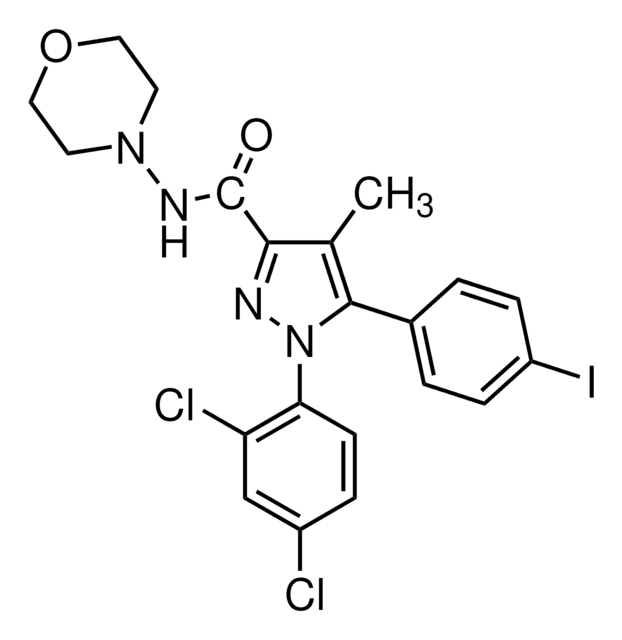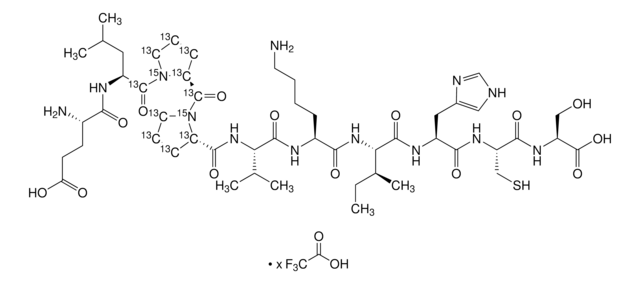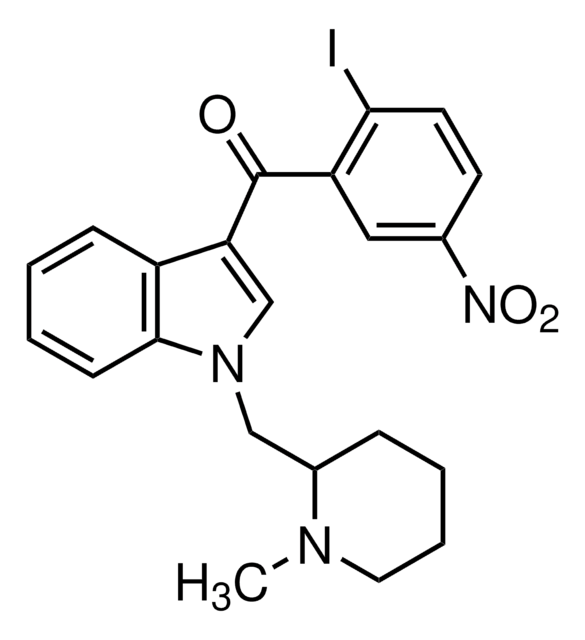Wszystkie zdjęcia(1)
Key Documents
SML1804
AM4113
≥98% (HPLC)
Synonim(y):
5-(4-Chlorophenyl)-1-(2,4-dichlorophenyl)-4-methyl-1H-pyrazole-3-carboxamide
Zaloguj sięWyświetlanie cen organizacyjnych i kontraktowych
About This Item
Wzór empiryczny (zapis Hilla):
C17H12Cl3N3O
Numer CAS:
Masa cząsteczkowa:
380.66
Kod UNSPSC:
12352200
Identyfikator substancji w PubChem:
NACRES:
NA.77
Polecane produkty
Poziom jakości
Próba
≥98% (HPLC)
Postać
powder
kolor
white to brown
rozpuszczalność
DMSO: 2 mg/mL, clear (warmed)
temp. przechowywania
2-8°C
ciąg SMILES
ClC1=CC(Cl)=C(N2C(C3=CC=C(Cl)C=C3)=C(C)C(C(N)=O)=N2)C=C1
Działania biochem./fizjol.
AM4113 is a Cannabinoid CB-1 neutral antagonist. AM4113 reduced reward and reinstatement of drug-seeking behavior, reducing cue-induced reinstatement in monkeys trained to self-administer cocaine.
AM4113 is a pyrazole-3-carboxamide analog of rimonabant (SR141716A). In rats, it suppresses food-motivated behaviors and food intake, thereby reducing weight gain without inducing nausea. AM4113 has poor oral bioavailability. Therefore, it may not act as an effective appetite suppressant in humans.
This page may contain text that has been machine translated.
Zwroty wskazujące rodzaj zagrożenia
Zwroty wskazujące środki ostrożności
Klasyfikacja zagrożeń
Aquatic Chronic 4
Kod klasy składowania
11 - Combustible Solids
Klasa zagrożenia wodnego (WGK)
WGK 3
Temperatura zapłonu (°F)
Not applicable
Temperatura zapłonu (°C)
Not applicable
Certyfikaty analizy (CoA)
Poszukaj Certyfikaty analizy (CoA), wpisując numer partii/serii produktów. Numery serii i partii można znaleźć na etykiecie produktu po słowach „seria” lub „partia”.
Masz już ten produkt?
Dokumenty związane z niedawno zakupionymi produktami zostały zamieszczone w Bibliotece dokumentów.
Charles W Schindler et al.
Neuropsychopharmacology : official publication of the American College of Neuropsychopharmacology, 41(9), 2283-2293 (2016-02-19)
Nicotine, the main psychoactive component of tobacco, and (-)-Δ(9)-tetrahydrocannabinol (THC), the main psychoactive ingredient in cannabis, play major roles in tobacco and marijuana dependence as reinforcers of drug-seeking and drug-taking behavior. Drugs that act as inverse agonists of cannabinoid CB1
K S Sink et al.
Pharmacology, biochemistry, and behavior, 91(3), 303-306 (2008-08-16)
Drugs that interfere with cannabinoid CB1 transmission suppress food-motivated behaviors, and may be clinically useful as appetite suppressants. Several CB1 receptor inverse agonists, such as rimonabant and AM251, as well as the CB1 receptor neutral antagonist, AM4113, have been assessed
Sherrica Tai et al.
Psychopharmacology, 232(15), 2751-2761 (2015-03-17)
Previous reports shows rimonabant's inverse properties may be a limiting factor for treating cannabinoid dependence. To overcome this limitation, neutral antagonists were developed, to address mechanisms by which an inverse agonist and neutral antagonist elicit withdrawal. The objective of this
Brian D Kangas et al.
The Journal of pharmacology and experimental therapeutics, 344(3), 561-567 (2013-01-05)
Cannabinoid receptor 1 (CB(1)) inverse agonists (e.g., rimonabant) have been reported to produce adverse effects including nausea, emesis, and anhedonia that limit their clinical applications. Recent laboratory studies suggest that the effects of CB(1) neutral antagonists differ from those of
T U C Järbe et al.
Pharmacology, biochemistry, and behavior, 91(1), 84-90 (2008-07-22)
We examined open-field effects in rats of the cannabinoid 1 receptor (CB1R) agonist WIN55,212-2 (WIN; 3 mg/kg) and its interaction with the CB1R putative neutral antagonist AM4113 (0.3 to 3 mg/kg). Separate studies examined AM4113 alone (0.3 to 5.6 mg/kg).
Nasz zespół naukowców ma doświadczenie we wszystkich obszarach badań, w tym w naukach przyrodniczych, materiałoznawstwie, syntezie chemicznej, chromatografii, analityce i wielu innych dziedzinach.
Skontaktuj się z zespołem ds. pomocy technicznej








